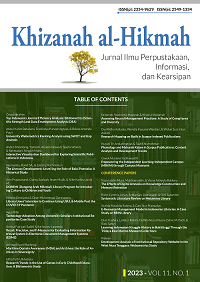DOREMI (Dongeng Arek Milenial): Library Program for Introducing Culture to Children and Youth
Abstract
Libraries must embrace innovation, ensuring that users can easily access and enjoy the services offered. This research aims to assess the effectiveness of DOREMI (Millennial Arek Tales) services as a novel means of cultural introduction. Employing a quantitative approach with descriptive research, the study utilized non-probability sampling, involving 100 respondents. Research methods included observation, distribution of questionnaires, and documentation. The study found that the DOREMI Live Streaming Service Innovation Program (Fairy Tales of Millennials) at the Tulungagung Regency Regional Library adheres to all principles of program innovation, encompassing program objectives, socialization, observations, and effectiveness. A significant 64% of respondents agreed that the DOREMI program enhances information and motivates them to engage in reading, while an equal percentage found the program organized by the library to be interesting. Additionally, 74% strongly agreed that participating in the DOREMI service imparted moral messages from the stories. The services provided an engaging and entertaining platform for storytelling, contributing to the promotion of cultural diversity and heritage within society. This enriches people's knowledge and understanding of various cultures. In conclusion, the services proved highly effective as a medium for introducing culture to the millennial generation in today's era.
Downloads
References
Agusriani, A., Sumiati, S., Ismail, W., Nurhayati, A., & Rachmatiah, S. (2022). Penggunaan Alat Peraga Dalam Metode Bercerita Untuk Meningkatkan Perbendaharaan Kata Anak 5-6 Tahun. KHIDMAH: Jurnal Pengabdian Kepada Masyarakat, 2(2), 141–150. https://doi.org/10.24252/khidmah.v2i2.30214
Sulistyawan, B. (2020). Generasi Millennial Sumber Ide. Kementerian Keuangan Republik Indonesia. https://www.djkn.kemenkeu.go.id/artikel/baca/13270
Yolanda, H., C. (2015). Pengaruh Pemberian Kegiatan Storytelling Terhadap Minat Kunjung Anakke Perpustakaan: Studi Kasus Pada Perpustakaan Komunitas Jendela Semarang. Jurnal Ilmu Perpustakaan, 3(1), 22–34. https://doi.org/https://ejournal3.undip.ac.id/index.php/jip/article/view/9347
Fadhli, R., Indah, R. N., Widya, N., & Oktaviani, W. (2020). Strategi Perpustakaan Sekolah Dasar Dalam Mengembangkan Emotional Branding Melalui Storytelling. JMIE (Journal of Madrasah Ibtidaiyah Education), 4(1), 68. https://doi.org/10.32934/jmie.v4i1.172
Febrina, A. (2021). Penerapan Metode Storytelling untuk Meningkatkan Percaya Diri Dan Kemampuan Berbicara Siswa (Studi Pada Kelas X Mata Pelajaran Bahasa Inggris di SMA Negeri 1 Pagar Alam). Diadik: Jurnal Ilmiah Teknologi Pendidikan, 11(1), 88–99. https://doi.org/10.33369/diadik.v11i1.18371
Harahap, H. S., Rahmadhani, B., Wardhani, A. D., Hawary, M. G., & Rukmana, A. A. (2020). Inovasi Pelayanan Perpustakaan Keliling Sebagai Media Revolusi Mental di Jawa Barat. Ministrate: Jurnal Birokrasi Dan Pemerintahan Daerah, 2(2), 63–74. https://doi.org/10.15575/jbpd.v2i2.9384
Khairoes, D., & Taufina, T. (2019). Penerapan Storytelling Untuk Meningkatkan Keterampilan Berbicara Di Sekolah Dasar. Jurnal Basicedu, 3(4), 1038–1046. https://doi.org/10.31004/basicedu.v3i4.220
Manita, R. J., Islam, U., Mahmud, N., & Batusangkar, Y. (2022). Layanan story telling pada layanan anak dan remaja di era modern. 24(2), 162–173. https://doi.org/10.22373/adabiya.v24i2.14582
Rahmawati, Y. (2015). Pengenalan Budaya Melalui Bercerita untuk Anak Usia Dini. Jurnal Pendidikan Anak, 1(1). https://doi.org/10.21831/jpa.v1i1.2908
Ramdhani, I. S., & Sumiyani, S. (2020). Literasi Seni Budaya Mendongeng Boneka Tangan Dalam Mengembangkan Karakter Generasi Milenial. Lingua Rima: Jurnal Pendidikan Bahasa Dan Sastra Indonesia, 9(1), 49. https://doi.org/10.31000/lgrm.v9i1.2399
Sugiyono. (2018). Metode Penelitian Kuantitatif, Kualitatif, dan R&D. Alfabeta.
Copyright (c) 2023 Arin Prajawinanti, Darisy Syafaah, Imam Mujib, Nike Karlina Junia M.

This work is licensed under a Creative Commons Attribution-NonCommercial-ShareAlike 4.0 International License.
By submitting your manuscript to our journal, you are following Copyright and License

